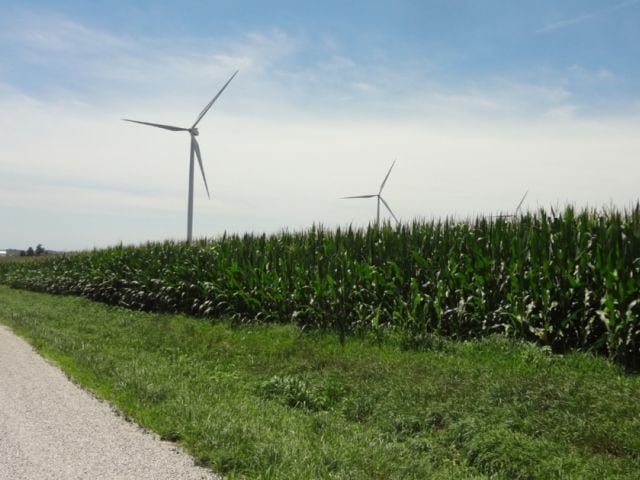In much of America’s farm country, nitrate contamination of drinking water, largely caused by polluted runoff from crop fields, poses a serious health risk – and the problem is getting worse, according to an Environmental Working Group analysis of data from 10 states.
Our investigation found that in the water of more than 2,100 utilities with the most serious problems, nitrate contamination has grown steadily worse. These community water systems1 serve almost 21 million people across vast stretches of the Midwest, Southwest, Atlantic Coast and California.
Data obtained under public records laws shows that between 2003 and 2017, tests detected elevated levels of nitrate in the tap water supplies of more than 4,000 community water systems in the states with the most widespread contamination – California, Illinois, Iowa, Kansas, Maryland, Nebraska, Oklahoma, Pennsylvania, Texas and Wisconsin.
Those water systems supply tap water for more than 45 million Americans. Each of the systems was contaminated with nitrate at or above 3 milligrams per liter, or mg/L, at least once in those 15 years. The Environmental Protection Agency considers 3 mg/L in groundwater used for drinking water an indication of contamination above naturally occurring levels.2
In 52 percent of those communities, serving 20.7 million people, nitrate contamination is getting worse. In California, Kansas and Texas, it’s getting worse in almost 60 percent of the communities with elevated nitrate levels.
This interactive map shows the systems that had at least one nitrate test at or above 3 mg/L between 2003 and 2017 and whose contamination levels went up during that period. Clicking on a state links to a more detailed interactive map for that state, with information about each system.
In Thousands of Communities, Nitrate Contamination of Drinking Water Is Getting Worse
Source: EWG, from state data obtained under open records laws.
EWG’s analysis underscores what we reported in a study and map released in October 2019. The earlier analysis found that two-year average nitrate contamination, from 2016 and 2017, in almost 1,700 towns and cities were at or above the level that a meta-analysis found increases the risk of colon, kidney, ovarian and bladder cancers.
Health Hazards of Nitrate
Nitrate is a primary chemical component of fertilizer and manure that can run off farm fields and seep into drinking water supplies. Although nitrate pollution can also come from wastewater treatment plants and septic systems, fertilizer and manure are the main culprits in agriculture-heavy regions.
Under the federal Safe Drinking Water Act, the legal limit for nitrate in drinking water is 10 mg/L. This limit was set in 1962 to guard against so-called blue baby syndrome, a potentially fatal condition that starves infants of oxygen if they ingest too much nitrate.
But more recent studies have shown strong evidence of an increased risk of colorectal cancer, thyroid disease and neural tube birth defects at levels of 5 mg/L or even lower. People who are concerned about nitrate in their tap water can look up their water system in EWG’s Tap Water Database.
Eighty-six percent of the communities with elevated levels of nitrate rely on groundwater for their drinking water. Our analysis found that contamination is not only getting worse in places with nitrate tests above 3 mg/L – it’s also getting worse in many places that exceeded the EPA’s legal limit, or the lower level linked to cancer and other health effects.
- In the 10 states we investigated, of the 991 communities where tests found nitrate above the EPA legal limit at least once, drinking water contamination got worse in almost half – 461 systems serving almost 9.9 million Americans.
- Of the 2,771 communities that tested at or above 5 mg/L, contamination got worse in 51 percent – 1,422 systems serving 15.9 million people.
Who Is Affected?
In the period studied, the smallest communities were more likely to have worsening contamination. Eighty percent of systems with worsening nitrate contamination served 3,300 or fewer people. For all states except California, two-thirds of communities with growing nitrate levels were in a rural area, rather than an urban area, as defined by the U.S. Census Bureau.
California is a special case, because so much of the state’s farming is located in what’s known as the urban-agricultural interface, with vast crop acreage inside urban areas. For example, Fresno, a city of more than 500,000 people, is surrounded by 1.88 million acres of cropland in Fresno County, the nation’s most productive agricultural county. Our analysis found that 71 percent of California communities with worsening nitrate contamination were in urban areas. For more detail, see the California profile.
In the table below, systems are categorized according to the EPA’s community size classifications.
Eighty Percent of Communities Where Nitrate Contamination Rose Were Small or Very Small
| System size | System count | Percent of systems |
|---|---|---|
| Very small (<501) | 1,114 | 53% |
| Small (501-3,300) | 577 | 27% |
| Medium (3,301-10,000) | 188 | 9% |
| Large (10,001-100,000) | 196 | 9% |
| Very large (>100,000) | 36 | 2% |
Source: EWG, from state data and EPA community size classifications.
Removing nitrate from tap water is expensive. A city can spread the cost of treatment over a large customer base. But in small communities, the increased cost of treatment per person could be hundreds or even thousands of dollars a year, depending on the technology used. For more information on the potential cost of nitrate treatment, see this EWG report.
State-by-State Results
Details for each state are available in the state profiles found here:
California
Illinois
Iowa
Kansas
Maryland
Nebraska
Oklahoma
Pennsylvania
Texas
Wisconsin
To see the methods used in this study and detailed results, click here.
Notes
1 Community water systems are public water supplies that serve residents in cities and towns year-round.
2 U.S. EPA, Estimated Nitrate Concentrations in Groundwater Used for Drinking. “While nitrate does occur naturally in groundwater, concentrations greater than 3 mg/L generally indicate contamination (Madison and Brunett, 1985), and a more recent nationwide study found that concentrations over 1 mg/L nitrate indicate human activity” (Dubrovsky et al. 2010).




